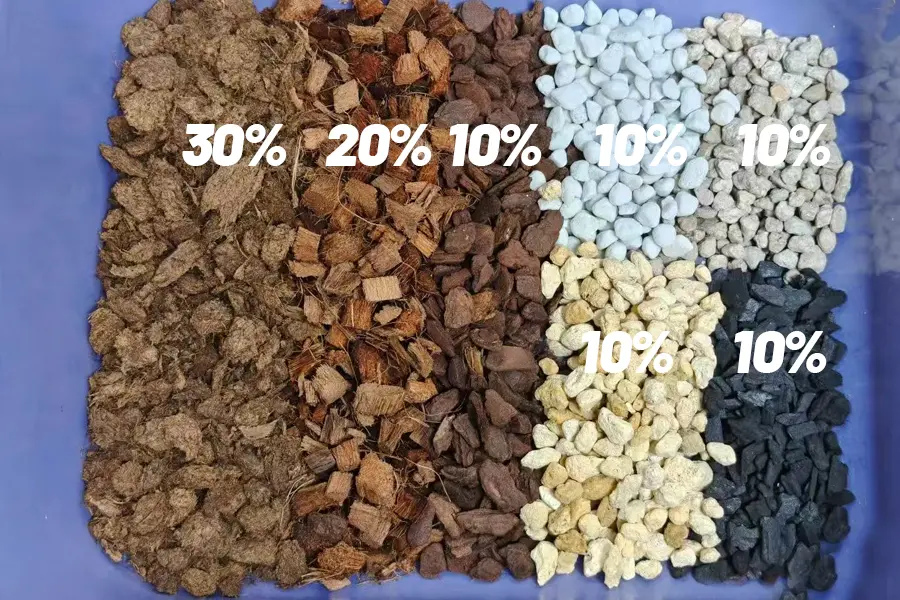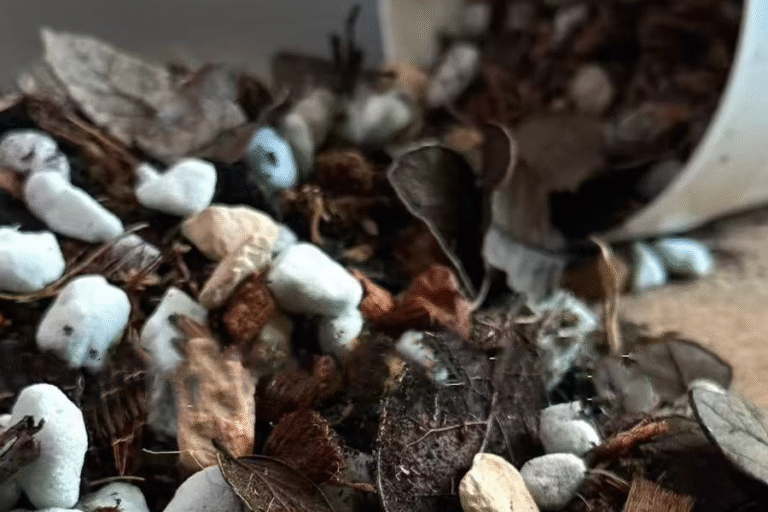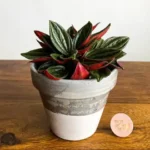1. Universal Leaf Plant Soil Mix (All-Purpose Blend)
Best for: Philodendrons, Peperomias, Chinese Evergreen, Calatheas
Why it works: Balances moisture retention with breathability. Suitable for most foliage plants in indoor settings.
Ingredients:
- 40% Coconut Coir or Peat Moss (moisture retention)
- 30% Perlite (drainage and aeration)
- 20% Compost or Worm Castings (nutrients)
- 10% Orchid Bark (structure and microbial health)
Tips:
- Add a pinch of dolomitic lime if using peat moss to balance pH.
- Replenish compost every 4–6 months.
2. Best Potting Mix for Tropical Plants like Monstera Deliciosa
This tropical-friendly soil blend is ideal for Monstera and other aroids. It promotes root aeration, retains the right amount of moisture, and prevents rot—crucial for plants from humid rainforests.

🧪 Soil Recipe (by volume):
- Coco peat / Coconut Husk Chunks– 20% Enhances water retention and adds organic bulk.
- Charcoal – 30% Detoxifies the soil and improves aeration.
- Pine Bark – 10% Mimics forest floor structure, encourages drainage.
- Leca / Lightweight Clay Pebbles – 10% Increases porosity and airflow to roots.
- Lava Rock – 10% Durable, non-decomposing aggregate to enhance drainage.
- Zeolite – 10% Absorbs and slowly releases nutrients and regulates pH.
- Bamboo Charcoal – 10% Improves root oxygenation and controls bacteria/fungi.
🌱 Why This Works for Monstera:
- Monsteras are hemi-epiphytes and grow in loose, chunky substrate in nature.
- This blend provides a moist yet airy environment, reducing the risk of overwatering.
- It also creates a biologically active, well-draining medium that prevents root suffocation.
📌 Care Tips with This Mix:
- Water when top 2–3 cm dries out.
- Fertilize lightly every 3–4 weeks during growing season.
- Consider a breathable pot (e.g. terra cotta or mesh nursery pot).
💡If you want to make your own variation, you can substitute:
- Rice husks for charcoal,
- Perlite for lava rock,
- Compost for added organic nutrients (up to 10%).
3. Aroid Soil Mix (For Monsteras, Philodendrons, Alocasias, Anthuriums)
Best for: Aroids that need chunky, breathable soil
Why it works: Mimics their native forest floor—airy, rich, and lightly moist.
Ingredients:
- 30% Orchid Bark (chunky texture)
- 25% Perlite or Pumice (drainage)
- 20% Coco Coir or Peat Moss (moisture)
- 15% Charcoal (purifies and boosts aeration)
- 10% Worm Castings (slow-release nutrients)
Tips:
- Charcoal helps reduce rot and fungus gnat issues.
- Perfect for semi-epiphytic root systems.
4. Moisture-Loving Mix (For Ferns, Calatheas, Fittonia, Maranta)
Best for: Plants that love consistent moisture and high humidity
Why it works: Holds water longer while still preventing soggy roots.
Ingredients:
- 50% Coco Coir or Sphagnum Peat Moss
- 20% Vermiculite (holds water)
- 15% Perlite (aeration)
- 10% Compost
- 5% Activated Charcoal (prevents root rot)
Tips:
- Water evenly and consistently—don’t let the mix dry out completely.
- Keep in high humidity rooms (bathrooms are ideal).
5. Succulent Leaf Mix (For Hoyas, Dischidia, Lipstick Plants)
Best for: Leafy succulents or semi-succulents
Why it works: Well-drained and slightly drier, prevents root rot in thick-leaved species.
Ingredients:
- 40% Cactus Mix or Sand
- 25% Pumice or Perlite
- 20% Orchid Bark
- 10% Coco Coir
- 5% Worm Castings
Tips:
- Let the top 1–2 inches of soil dry out between waterings.
- Suitable for hanging plants exposed to brighter light.
6 DIY Indoor Potting Mix for Low-Light Plants
Best for: ZZ Plants, Snake Plants, Pothos
Why it works: Retains enough moisture without encouraging rot in slow-growing plants.
Ingredients:
- 40% Peat Moss or Coco Coir
- 30% Perlite
- 20% Sand or Fine Bark
- 10% Organic Compost
Tips:
- These plants need time to dry between waterings—do not overwater.
- Use a breathable terracotta pot to avoid water buildup.
7. Sustainable Soil Mix (Peat-Free + Organic)
Best for: Eco-conscious plant parents with mixed plant collections
Why it works: 100% sustainable ingredients without sacrificing performance.
Ingredients:
- 40% Coconut Coir (renewable)
- 30% Rice Hulls (aeration, peat substitute)
- 20% Organic Compost
- 10% Biochar or Activated Charcoal
Tips:
- Rice hulls naturally biodegrade and improve soil texture.
- Reapply compost every 6–8 months to maintain nutrient content.
Comparison Table: Which Soil Mix Should You Use?
| Plant Type | Ideal Mix Name | Drainage | Moisture Retention | Nutrient Rich | Sustainable |
|---|---|---|---|---|---|
| Most foliage houseplants | Universal Leaf Mix | ✅✅ | ✅✅✅ | ✅✅✅ | ✅✅ |
| Monsteras, Alocasias | Aroid Mix | ✅✅✅ | ✅✅ | ✅✅✅ | ✅ |
| Calatheas, Ferns | Moisture-Loving Mix | ✅ | ✅✅✅✅ | ✅✅ | ✅ |
| Hoyas, Lipstick Plants | Succulent Leaf Mix | ✅✅✅ | ✅ | ✅ | ✅✅✅ |
| Snake, ZZ, Pothos | Low-Light Plant Mix | ✅✅ | ✅✅ | ✅✅ | ✅ |
| Mixed or eco gardens | Sustainable Soil Mix | ✅✅ | ✅✅✅ | ✅✅ | ✅✅✅✅ |
Pro Tips for Making Your Own Soil Mix
- Sterilize ingredients like compost or garden soil before use to avoid pests.
- Use gloves when mixing and store extras in sealed containers.
- Adjust based on environment: High humidity? Add more perlite. Dry air? Add more coco coir.
- Check your plant’s roots every 6–12 months and refresh soil to prevent compaction or salt buildup.








